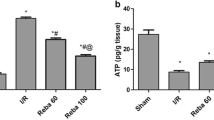Abstract
Warm ischemia and reperfusion (WI/R) results in the release of destructive proinflammatory cytokines and oxygen free radicals, which in turn cause injury to the liver. Apoptosis is regarded as the central mechanism of liver injury during WI/R. Oxymatrine, an extract from a traditional Chinese herb, Sophora flavescens Ait, has been widely used for the treatment of chronic hepatitis, by virtue of its anti-inflammatory and anti-apoptotic activity. The objective of this study was to investigate whether administration of oxymatrine could protect livers against WI/R. The experimental design consisted of three groups of rats (each group contained 10 Wistar rats): one group were treated by sham-operation; the second (control) group with WI/R were administrated saline, and the third group, rats with WI/R, were administered oxymatrine). Oxymatrine was intravenously administered before a 30-minute period of ischemia. Blood samples were collected for biochemical assay. Liver samples taken at different time points underwent histological examination for detection of apoptotic cells, and Western blotting analysis for Fas and Fas ligand, the key factors in the upper apoptotic pathways. Histologic alteration of the liver was attenuated in oxymatrine-treated rats, and the serum levels of AST and ALT were significantly (P < 0.01) reduced (73% and 61%, respectively). Oxymatrine significantly inhibited cell apoptosis, as examined by terminal deoxynucleotidyl transferase-mediated dUTP nick end-labeling (TUNEL), and it reduced the apoptotic index by 65% (P < 0.05%) as detected by flow cytometry. The anti-apoptotic activity of oxymatrine depends mainly on downregulation of Fas and Fas ligand. The results of this study indicate that oxymatrine may represent a potent drug to protect the liver against WI/R injury.


Similar content being viewed by others
References
Belghiti J, Noun R, Malafosse R, et al. Continuous versus intermittent portal triad clamping for liver resection: a controlled study. Ann Surg 1999;229:369–375
Barinaga M. Forging a path to cell death. Science 1996;273:735–737
Parks DA, Granger DN. Contributions of ischemia and reperfusion to mucosal lesion formation. Am J Physiol 1986;250:G749–G753
Selzner M, Rudiger HA, Sindram D, et al. Mechanisms of ischemic injury are different in the steatotic and normal rat liver. Hepatology 2000;32:1280–1288
Kohli V, Madden JF, Bentley RC, et al. Calpain mediates ischemic injury of the liver through modulation of apoptosis and necrosis. Gastroenterology 1999;116:168–178
Rudiger HA, Kang KJ, Sindram D, et al. Comparison of ischemic preconditioning, intermittent and continuous inflow occlusion in the murine liver. Ann Surg 2002;235:400–407
Rudiger HA, Clavien PA. Tumor necrosis factor-alpha, but not Fas, mediates hepatocellular apoptosis in the murine ischemic liver. Gastroenterology 2002;122:202–210
Selzner M, Rudiger HA, Selzner N, et al. Bcl-2 overexpression in transgenic mice protects against ischemia and reperfusion injury of the liver. J. Hepatol. 2002;36:218–225
Rudiger HA, Clavien PA, et al. A cytotoxic drug against reperfusion injury? Hepatology 2000;31:533–535
Chen XS, Wang GJ, Cai X, et al. Inhibition of hepatitis B by oxymatrine in vivo. World J Gastroenterol 2001;7:49–52
Huang YQ, Lin ZH, Ji SM, et al. Effect of expression of Fas/FasL of chronic hepatitis B undergoing treatment with oxymatrine. J. Postgrad. Med. 2004;27:19–20 (in Chinese)
Wang J, Wang G, Cai X, He P. Effect of oxymatrine and glycyrrhizin on hepatocyte apoptosis induced by cessation of phenobarbital treatment in mice. Acad J Sec Mil Med Univ 1999;20:222–224 (in Chinese)
Rudiger HA, Graf R, Clavien PA. Liver ischemia: apoptosis as a central mechanism of injury. J Invest Surg 2003;16:149–159
Wei L, Zhang X, Ma S, et al. Treatment of acute pancreatitis with somatostatin and oxymatrine in rats. Acad J Sec Mil Med Univ 1999;20:633–635 (in Chinese)
Gan L, Wang G, Li Yu. Protective effects of oxymatrine on chronic liver damage in rats. Chin. Traditional Herbal Drugs 2002;33:339–341 (in Chinese)
Sun Y, Gong S, Huang Z. Effects of oxymatrine on TNF-alpha, IL-6 and IL-8 in chronic hepatitis B patients. Clin Med China 2003;19:10–12 (in Chinese)
Qin Z, Den H, Zhuang H. Effect of oxymatrine on prolonging the survival time of cardiac tissue allograft in mice and its immunologic mechanisms. Chung His I Chieh Ho Tsa Chih [Chin. J Mod Dev Traditional Med 1990;10:99–100 (in Chinese)
Li P, Nijhawan D, Budihardjo I, et al. Cytochrome c and dATP-dependent formation of Apaf-1/caspase-9 complex initiates an apoptotic protease cascade. Cell 1997;91:479–489
Hatano E, Bradham CA, Stark A, et al. The mitochondrial permeability transition augements Fas-induced apoptosis in mouse hepatocytes. J Biol Chem 2000;275:11814–11823
Faubion WA, Gore GJ. Death receptors in liver biology and pathobiology. Hepatology 1999;29:1–4
Natori S, Selzner M, Valentino KL, et al. Apoptosis of sinusoidal endothelial cells occurs during liver preservation injury by a caspase-dependent mechanism. Transplantation 1999;68:89–96
Cursio R, Gugenheim J, Ricci JE, et al. Caspase inhibition protects from liver injury following ischemia and reperfusion in rats. Transplatat Int 2000;13:S568–572
Acknowledgments
This work was supported by the National Natural Scientific Foundation of China (30471681); the Collaborative Fund for Oversea Scholars from The Science and Technology Bureau of Heilongjiang Province, China (WHO5CO2); and the Creative Foundation for Postgraduates at Harbin Medical University (200301076) to M.F. J.H. and M.F. contributed equally to this work.
Author information
Authors and Affiliations
Corresponding author
Rights and permissions
About this article
Cite this article
Jiang, H., Meng, F., Li, J. et al. Anti-apoptosis Effects of Oxymatrine Protect the Liver from Warm Ischemia Reperfusion Injury in Rats. World J. Surg. 29, 1397–1401 (2005). https://doi.org/10.1007/s00268-005-7885-y
Published:
Issue Date:
DOI: https://doi.org/10.1007/s00268-005-7885-y




